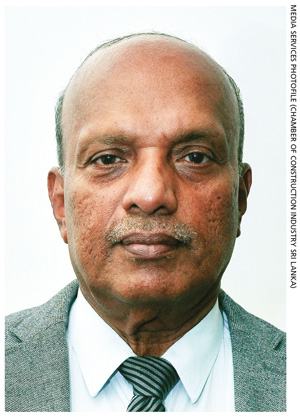CONSTRUCTION INDUSTRY
Compiled by Savithri Rodrigo
LAYING A NEW FOUNDATION
Major Ranjith Gunathilake makes a case for better project implementation

Q: How do you view the prevailing construction landscape?
A: Our construction milieu was in bad shape even prior to the Easter Sunday attacks, which has placed not only the industry but the entire country in dire straits.
Prior to the bombings, there was conjecture about the stability of the real estate sector with some projects being stalled due to financial issues. As a result, confidence in the industry wasn’t upbeat.
The ROI in this industry can take an inordinate amount of time – sometimes as long as 12 years compared to six or seven years in the Maldives. This does not instil confidence in investors as they seek a viable time span for ROI – less than 10 years in an era where everything is uncertain.
Q: What are the threats to and weaknesses of the industry?
A: The entire approval process from A to Z. Projects take excessive time to get off the ground due to the approval process being long-winded and multi-pronged.
In addition, interest rates are high and there is no policy consistency. The lack of discipline is another major weakness, which the industry must address. Rules and regulations do apply to some but not across the board. All these factors cause delays.
Q: Which policies can inject vibrancy?
A: The National Construction Policy is a positive. It must be implemented by the Chamber of Construction Industry Sri Lanka (CCISL) and other stakeholders. And discipline is the key to implementation.
There is a colossal number of ministries – at least six or seven, when it should be two or three – covering the industry, which leads to delays. Political stability and security are imperative. Without proper leadership direction, it is difficult for the construction industry to grow.
Q: How do you view China’s role in the industry?
A: China is impacting the world; not only Sri Lanka or our construction industry. Whether it’s in the East or West, the US or Australia, China’s influence is far-reaching. But the number one priority is to regulate the real estate sector not only for China but any foreign parties entering it.
Currently, there’s a process implemented by the Construction Industry Development Authority (CIDA). Foreign collaboration in any form must take the form of a joint venture.
Q: And how are R&D and innovation impacting construction?
A: Ideally, there should be an industry task force assigned with R&D at a very high level of engagement to bring all ministries under a single umbrella. It should comprise high-level competent experts from the private sector. Sadly, Sri Lanka doesn’t maximise the vast knowledge and expertise of its people.
Q: What are the emerging global trends – and do you think they apply to Sri Lanka?
A: There is good infrastructure development here in Sri Lanka with the application of global trends whether in irrigation or roads and some world-class real estate projects too.
However, project execution continues to be difficult with successive governments making the operating environment challenging to meet delivery timelines. For example, the light rail transit has been approved but may take a long time to come to fruition. In the main, there’s only rhetoric but never the urgency to make these priorities.
Q: Is green construction garnering adequate attention?
A: Sri Lanka has by and large followed a green ethos when it comes to construction. However, with new trends emerging and the West making a conscious effort to embrace green construction, the dynamics have changed.
Unfortunately, Sri Lanka is losing that green consciousness to modern developmental demands. A quarter of a century ago, Singapore was perceived as a concrete jungle with the extent of development it was pursuing. But look at Singapore today with its lush green spaces.
While the lowly industry is gradually moving towards green construction, the higher cost could mean that stakeholders are hesitant to go ahead. Nevertheless, it is imperative that we as an industry work towards this.
Q: Which strengths would take the construction industry forward?
A: Construction accounts for eight to 12 percent of GDP through foreign exchange inflows, employment and development. This must be protected and the ‘doing business’ environment made conducive to foreign direct investment.
We must develop our labour force, ensure that rules and regulations are in place, minimise delays, instil discipline, and optimise the knowledge and competencies of engineers who are underutilised. Industry decision makers must comprise a majority of engineers, which is a definite strength, to instil confidence in investors.




